OUC's Solar Projects
OUC is committed to making solar energy affordable and accessible to all customers. OUC has two large community solar farms, bringing customers the opportunity to use solar power without paying for costly equipment and installation.
OUC also found creative ways to use the sun's power — adding a floating solar array at our Gardenia facility and installing several solar sculptures around town.
 Harmony II and Storey Bend Solar Farms
Harmony II and Storey Bend Solar Farms
The largest solar power project in OUC history is nearing completion, with an area the equivalent of 757 football fields blanketed in photovoltaic panels in rural Osceola County. When operational, OUC’s solar capacity will more than double – as will overall renewable energy production. OUC will also be the top solar producer among Florida municipal utilities by a significant margin.
The Harmony II and Storey Bend solar farms, both with 74.5 MW of capacity, will each have 300,000 panels on separate 500-acre sites. When completed, OUC will be the sole recipient of the combined 149 MW of clean energy through a 20-year power purchase agreement with Florida Renewable Partners, a division of NextEra Energy, which is building and will operate the farms. The new facilities join OUC’s existing solar energy portfolio, which includes 108.5 MW of capacity at the Taylor Creek and Harmony Solar Energy Centers. Read More >
The farms are anticipated to come online by December 2024.
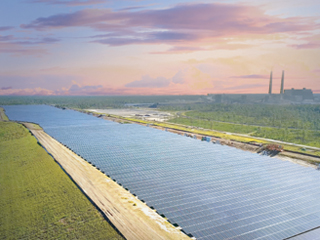 Kenneth P. Ksionek Community Solar Farm
Kenneth P. Ksionek Community Solar Farm
The Kenneth P. Ksionek Community Solar Farm at the Stanton Energy Center (SEC) is unique in that it’s one of the first solar farms in the country that sits atop a closed byproduct landfill at a power plant.
The new facility will more than double OUC’s solar capacity. The community solar farm gives OUC’s residential and business customers access to sustainable, maintenance-free solar energy without the hassles and costs associated with installing panels on their homes or businesses.
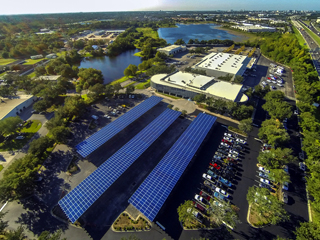 A First for Central Florida
A First for Central Florida
In 2013, OUC developed Central Florida’s first community solar farm at our Gardenia facility.
The 400 kW array produces an average of 540,000 kWh annually, which is enough energy to meet the power needs of about 40 homes and is equivalent to avoiding 949,316 pounds of carbon dioxide emissions. It also acts as covered parking for employees and visitors.
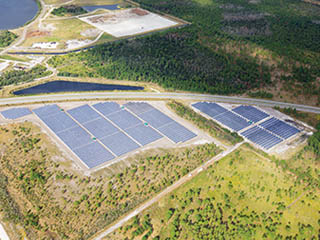 Curtis H. Stanton Energy Center
Curtis H. Stanton Energy Center
Orange County's first solar farm is OUC's Curtis H. Stanton Energy Center along Innovation Way. The 5.9-megawatt solar photovoltaic (PV) array in east Orange County can generate enough renewable energy to power more than 600 homes. The solar farm adds to an already diverse fleet of clean, reliable generation at OUC’s 3,280-acre Stanton Energy Center, which is home to natural gas, landfill gas and coal.
OUC customers who travel along Innovation Way can see more than 25,000 PV modules that are generating renewable energy. The solar panels feature a patented single-axis tracking system that increases electricity output by up to 30 percent and can withstand hurricane-force winds in the stow position.
OUC sells some or all of its renewable energy to others or third parties.
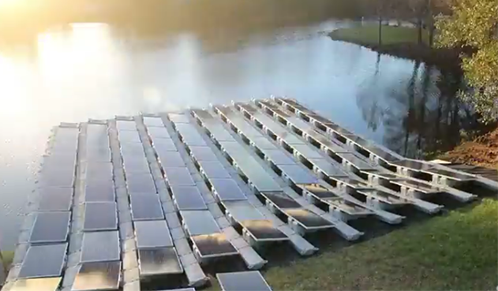 Floating Solar Array
Floating Solar Array
In 2017, OUC found a new way to weave sustainability into its clean-energy portfolio by installing a floating solar array on a large pond next to the Gardenia Operations Facility.
The array sends up to 31.5 kW of electricity back into the grid. The reflectivity of the pond water helps increase the capacity of the more than 100 panels.
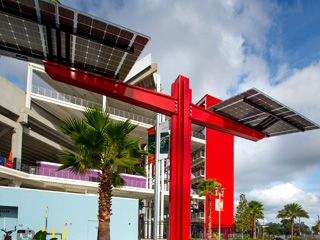 Solar Sculptures
Solar Sculptures
OUC is providing sustainable products and services in our service territory. We are planting new solar trees at key sites that are fully functional solar structures that we are using to enrich and educate our customers on the unique benefits of solar power.
OUC has also invested in solar on bus shelters, solar on utility poles and has been an area leader in installing utility-scale projects atop the Orange County Convention Center and at our Stanton Energy Center. Solar energy has also been used to offset some of the needs of one of the most advanced Electric Vehicle (EV) infrastructures in the southeast.